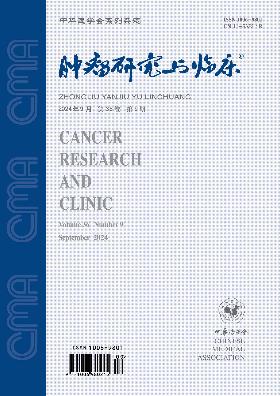Characterization of liver cancer-targeted doxorubicin coupling segmented copolymer nanomicelles and its inhibitory effect on hepatocellular carcinoma HepG2 and Huh7 cells
Q4 Medicine
引用次数: 0
Abstract
Objective To investigate the characterization of doxorubicin (DOX) coupling segmented copolymer nanomicelles with dual effects of passive and active targeting to liver cancer and its antineoplastic function in vitro. Methods DOX was covalently conjugated to a terminal hydroxyl group of poly lactic-co-glycolic acid-poly ethylene glycol (PLGA-PEG) diblock copolymer to form DOX-PLGA-PEG. The formation of amido bond was determined by using fourier transform infrared spectroscopy (FTIR) and magnetic resonance method. Amphiphatic diblock copolymer DOX-PLGA-PEG could self-assemble to form nanomicelles in an aqueous phase by dialysis method. The DOX-PLGA-PEG targeted micelles decorated with liver cancer HAb18 F (ab')2 specific antibody were prepared by using physical bonding method. The size and the scattering scope of nanomicelles was determined by using granulometer and dynamic light scattering (DLS). Micelle morphology was examined by using scanning electron microscopy (SEM). The drug loading rate and entrapment rate of DOX-PLGA-PEG micelles or targeted micelles were measured by using ultraviolet spectrophotometry method, and stimulated release in vitro experiment was done. After administration of 2 mg/ml DOX-PLGA-PEG or targeted micelles, cell morphology change of liver cancer HepG2 and Huh7 was observed by using the phase-contrast photomicrography. After administration of 1 mg/ml DOX-PLGA-PEG or targeted micelles, cell survival was analyzed by using plate clone formation assay. Results The spectrum peak was around 1 575 cm-1 under the observation of FTIR, which was accord with the location of the peak of amido bond. Activating with p-nitrophenyl chloroformate, DOX was covalently conjugated to PLGA-PEG to produce DOX-PLGA-PEG via a carbamate linkage between the primary amine group in DOX and the terminal hydroxyl group in PLGA-PEG. DLS measurements showed that the diameter of DOX-PLGA-PEG micelles and targeted micelles was (55.0±6.3) nm and (87.6±9.3) nm, respectively, and polydispersity index was 0.098 and 0.142, respectively. SEM micrographs revealed that these nanomicelles had a spherical morphology and relatively smooth surface. Drug loading rate of DOX-PLGA-PEG micelles and targeted micelles was (2.4±0.2)% and (2.2±1.9)%, and the entrapment rate was (91.7±5.3)% and (87.5±4.8)%, respectively. The drug release curve in vitro of DOX-PLGA-PEG micelles and targeted micelles exhibited a biphasic pattern characterized by a fast initial release, followed by a slower and continuous release. The amount of the drug release rate was about 30% within 5 d, and 25% within 6 h. After 2 mg/ml DOX-PLGA-PEG micelles and targeted micelles, the cell morphology of liver cancer HepG2 and Huh7 had the impaired change, and the part of the cells were dead, the clonality decreased. The effect of targeted micelles was more significant compared with DOX-PLGA-PEG micelles. After DOX-PLGA-PEG micelles and targeted micelles, the survival rates of HepG2 and Huh7 cells were decreased with time, and the effect of targeted micelles was more effective compared with DOX-PLGA-PEG micelles (all P < 0.05). The 50% effective inhibition of the targeted micelles and DOX-PLGA-PEG micelles was obtained in 2.4 d and 5.5 d, respectively for Huh7 cells. At these time points, DOX concentration was 1.15 μg/ml and 1.24 μg/ml, respectively. The 50% effective inhibition of targeted micelles and DOX-PLGA-PEG micelles was obtained in 3.3 d and 7.4 d, respectively for HepG2 cells. At these time points, DOX concentration was 1.20 μg/ml and 1.31 μg/ml. Conclusion DOX nanomicelles with dual effects of passive and active targeting can release a large number of active drugs in vitro, which plays an obvious inhibitory role in the cell proliferation of liver cancer HepG2 and Huh7 cells. Key words: Liver neoplasms; Doxorubicin; Drug delivery systems; Molecular targeted therapy; Targeted micelles肝癌靶向阿霉素偶联片段共聚物纳米胶束的表征及其对肝癌HepG2和Huh7细胞的抑制作用
目的研究多柔比星(DOX)偶联节段共聚物纳米胶束对肝癌的主动和被动双重靶向作用及其体外抗肿瘤功能。方法将DOX与聚乳酸-羟基乙酸-聚乙二醇(PLGA-PEG)二嵌段共聚物末端羟基共价偶联,形成DOX-PLGA-PEG。利用傅里叶变换红外光谱(FTIR)和磁共振法测定了酰胺键的形成。两相二嵌段共聚物DOX-PLGA-PEG在水相中通过透析法自组装形成纳米胶束。采用物理键合法制备肝癌hab18f (ab’)2特异性抗体修饰的DOX-PLGA-PEG靶向胶束。采用粒度仪和动态光散射法测定了纳米胶束的大小和散射范围。用扫描电镜(SEM)观察胶束形态。采用紫外分光光度法测定DOX-PLGA-PEG胶束或靶胶束的载药率和包封率,并进行体外促释放实验。给药2 mg/ml DOX-PLGA-PEG或靶向胶束后,用相衬显微摄影观察肝癌细胞HepG2和Huh7的形态变化。给药1 mg/ml DOX-PLGA-PEG或靶向胶束后,用平板克隆形成实验分析细胞存活情况。结果FTIR光谱峰在1 575 cm-1附近,与酰胺键峰的位置一致。DOX被对硝基苯氯甲酸酯激活后,通过DOX的伯胺基团和PLGA-PEG末端羟基之间的氨基甲酸酯键与PLGA-PEG共价偶联,生成DOX-PLGA-PEG。DLS测定结果表明,DOX-PLGA-PEG胶束和靶胶束直径分别为(55.0±6.3)nm和(87.6±9.3)nm,多分散性指数分别为0.098和0.142。SEM显微照片显示,这些纳米胶束具有球形形态和相对光滑的表面。DOX-PLGA-PEG胶束和靶向胶束的载药率分别为(2.4±0.2)%和(2.2±1.9)%,包封率分别为(91.7±5.3)%和(87.5±4.8)%。DOX-PLGA-PEG胶束和靶向胶束的体外药物释放曲线均呈现先快速释放后缓慢连续释放的双相模式。5 d内释药量约为30%,6 h内释药量约为25%。2 mg/ml DOX-PLGA-PEG胶束和靶向胶束作用后,肝癌HepG2和Huh7细胞形态发生损伤改变,部分细胞死亡,克隆性下降。与DOX-PLGA-PEG胶束相比,靶向胶束的作用更为显著。DOX-PLGA-PEG胶束和靶向胶束作用后,HepG2和Huh7细胞的存活率随时间的延长而降低,且靶向胶束作用较DOX-PLGA-PEG胶束更有效(均P < 0.05)。对Huh7细胞,靶胶束和DOX-PLGA-PEG胶束分别在2.4 d和5.5 d获得50%的有效抑制。各时间点DOX浓度分别为1.15 μg/ml和1.24 μg/ml。对HepG2细胞,靶胶束和DOX-PLGA-PEG胶束的有效抑制作用分别在3.3 d和7.4 d达到50%。各时间点DOX浓度分别为1.20和1.31 μg/ml。结论DOX纳米胶束具有被动靶向和主动靶向双重作用,可在体外释放大量活性药物,对肝癌HepG2和Huh7细胞的增殖具有明显的抑制作用。关键词:肝脏肿瘤;阿霉素;给药系统;分子靶向治疗;有针对性的胶束
本文章由计算机程序翻译,如有差异,请以英文原文为准。
求助全文
约1分钟内获得全文
求助全文
来源期刊

肿瘤研究与临床
Medicine-Oncology
CiteScore
0.10
自引率
0.00%
发文量
7737
期刊介绍:
"Cancer Research and Clinic" is a series of magazines of the Chinese Medical Association under the supervision of the National Health Commission and sponsored by the Chinese Medical Association.
It mainly reflects scientific research results and academic trends in the field of malignant tumors. The main columns include monographs, guidelines and consensus, standards and norms, treatises, short treatises, survey reports, reviews, clinical pathology (case) discussions, case reports, etc. The readers are middle- and senior-level medical staff engaged in basic research and clinical work on malignant tumors.
 求助内容:
求助内容: 应助结果提醒方式:
应助结果提醒方式:


